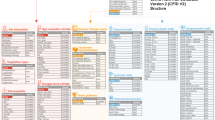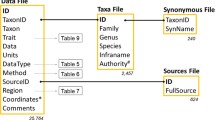Abstract
The general applicability of CSR classification (a methodology for applying CSR theory) has not been tested outside Britain. We hypothesised that principal axes of trait variation for plant species native to southern European continental, sub-alpine and alpine bioclimatic zones correlate with CSR classification scores. Functional traits were quantified in situ for 506 species of 57 families. Multivariate analysis revealed three main modes in which plants invested biomass: (1) architectural extension of individual ramets (tall canopies, large leaves), (2) durable tissues (high leaf dry matter contents and carbon contents, low specific leaf areas) or (3) regenerative development (early, extensive flowering with delicate, nitrogen-rich leaves). These were highly significantly correlated with the extent of competitive ability (C), stress-tolerance (S) and ruderalism (R), respectively, determined by CSR classification. Despite being calibrated using only 43 British species, CSR classification is consistent with trait variation in a phylogenetically broader sample of species native to a wider range of bioclimatic zones.

Similar content being viewed by others
References
Bell AD (1991) Plant form: an illustrated guide to flowering plant morphology. Oxford University Press, Oxford, UK
Caccianiga M, Luzzaro A, Pierce S, Ceriani RM, Cerabolini B (2006) The functional basis of a primary succession resolved by CSR classification. Oikos 112:10–20
Cerabolini B, Pierce S, Luzzaro A, Ossola A (2010) Species evenness affects ecosystem processes in situ via diversity in the adaptive strategies of dominant species. Plant Ecol 207(2):333–345
Ceriani RM, Pierce S, Cerabolini B (2008) Are morpho-functional traits reliable indicators of inherent relative growth rate for prealpine calcareous grassland species? Plant Biosyst 142:60–65
Ceriani RM, Pierce S, Cerabolini B (2009) The survival strategy of the alpine endemic Primula glaucescens is fundamentally unchanged throughout its climate envelope despite superficial phenotypic variability. Plant Ecol 204:1–10
Cornelissen JHC, Lavorel S, Garnier E, Diaz S, Buchmann N et al (2003) A handbook of protocols for standardised and easy measurement of plant functional traits worldwide. Aust J Bot 51:335–380
Díaz S, Hodgson JG, Thompson K, Cabido M, Cornelissen JHC et al (2004) The plant traits that drive ecosystems: evidence from three continents. J Veg Sci 15:295–304
Duckworth JC, Kent M, Ramsay PM (2000) Plant functional types: an alternative to taxonomic plant community description in biogeography? Prog Phys Geogr 24:515–542
Evans JR, Poorter H (2001) Photosynthetic acclimation of plants to growth irradiance: the relative importance of specific leaf area and nitrogen partitioning in maximizing carbon gain. Plant, Cell Environ 24:755–767
Everard B, Morley BD (1974) Wild flowers of the world. Octopus Books Ltd, London
Garnier E, Lavorel S, Ansquer P et al (2006) Assessing the effects of land-use change on plant traits, communities and ecosystem functioning in grasslands: a standardized methodology and lessons from an application to 11 European sites. Ann Bot 99(5):967–985
Gleeson SK, Tilman D (1994) Plant allocation, growth rate and successional status. Funct Ecol 8:543–550
Grime JP (1974) Vegetation classification by reference to strategies. Nature 250:26–31
Grime JP (1977) Evidence for the existence of three primary strategies in plants and its relevance to ecological and evolutionary theory. Am Nat 111:1169–1194
Grime JP (2001) Plant strategies, vegetation processes and ecosystem properties, 2nd edn. Wiley, Chichester, 417 p
Grime JP, Thompson K, Hunt R, Hodgson JG, Cornelissen JHC et al (1997) Integrated screening validates primary axes of specialisation in plants. Oikos 79:259–281
Grime JP, Hodgson JG, Hunt R (2007) Comparative plant ecology: a functional approach to common British species, 2nd edn. Unwin Hyman, London, 748 p
Hodgson JG, Wilson PJ, Hunt R, Grime JP, Thompson K (1999) Allocating CSR plant functional types: a soft approach to a hard problem. Oikos 85:282–294
Meziane D, Shipley B (2001) Direct and indirect relationships between specific leaf area, leaf nitrogen and leaf gas exchange. Effects of irradiance and nutrient supply. Ann Bot 88:915–927
Miller TE, Burns JH, Munguia P, Walters EL, Kneitel JM et al (2005) A critical review of twenty years’ use of the resource-ratio theory. Am Nat 165:439–448
Mokany K, Ash J, Roxburgh S (2008) Functional identity is more important than diversity in influencing ecosystem processes in a temperate native grassland. J Ecol 96:884–893
Olff H (1992) Effects of light and nutrient availability on dry-matter and N-allocation in six successional grassland species—testing for resource-ratio effects. Oecologia 89:412–421
Pierce S, Vianelli A, Cerabolini B (2005) From ancient genes to modern communities: the cellular stress response and the evolution of plant strategies. Funct Ecol 19:763–776
Pierce S, Luzzaro A, Caccianiga M, Ceriani RM, Cerabolini B (2007a) Disturbance is the principal α-scale filter determining niche differentiation, coexistence and biodiversity in an alpine community. J Ecol 95:698–706
Pierce S, Ceriani RM, De Andreis R, Luzzaro A, Cerabolini B (2007b) The leaf economics spectrum of Poaceae reflects variation in survival strategies. Plant Biosyst 141:337–343
Pignatti S (1982) Flora d’Italia. Edagricole, Bologna, 2302 p (in Italian)
Poorter H, De Jong R (1999) A comparison of specific leaf area, chemical composition and leaf construction costs of field plants from 15 habitats differing in productivity. New Phytol 143:163–176
Poorter H, Evans JR (1998) Photosynthetic nitrogen-use efficiency of species that differ inherently in specific leaf area. Oecologia 116:26–37
Poorter H, Van der Werf A (1998) Is inherent variation in RGR determined by LAR at low irradiance and by NAR at high irradiance? A review of herbaceous species. In: Lambers H, Poorter H, Van Vuuren MMI (eds) Inherent variation in growth rate. Backhuys Publishers, Leiden, Netherlands, pp 309–336
Reich PB, Ellsworth DS, Walters MB, Vose JM, Gresham C, Volin JC, Bowman WD (1999) Generality of leaf trait relationships: a test across six biomes. Ecology 80(6):1955–1969
Shipley B, Peters RH (1990) A test of the Tilman model of plant strategies: relative growth rate and biomass partitioning. Am Nat 136:139–153
Shipley B, Vile D, Garnier E, Wright IJ, Poorter H (2005) Functional linkages between leaf traits and net photosynthetic rate: reconciling empirical and mechanistic models. Funct Ecol 19:602–615
Tilman D (1988) Plant strategies and the dynamics and structure of plant communities. Princeton University Press, Princeton
Van der Werf A, van Nuenen M, Visser AJ, Lambers H (1993) Contribution of physiological and morphological plant traits to a species’ competitive ability at high and low nutrient supply. Oecologia 94:434–440
Van Wijk MT, Williams M, Gough L, Hobbie SE, Shaver GR (2003) Luxury consumption of soil nutrients: a possible competitive strategy in above-ground and below-ground biomass allocation and root morphology for slow-growing arctic vegetation. J Ecol 91:664–676
Weiher E, Van Der Werf A, Thompson K, Roderick M, Garnier E, Eriksson O (1999) Challenging Theophrastus: a common core list of plant traits for functional ecology. J Veg Sci 10:609–620
Wright IJ, Reich PB, Westoby M, Ackerley DD, Baruch Z et al (2004) The worldwide leaf economics spectrum. Nature 428:821–827
Acknowledgements
Comments by Eric Garnier and David Ackerly improved earlier versions of the manuscript. This study was funded by the Native Flora Centre of the Lombardy Region (CFA), based at Parco Monte Barro, Lecco, Italy, and the University of Insubria, Varese. SP was funded in part by a research fellowship (assegno di ricerca) from the Italian government and then as a fixed-term researcher/junior lecturer (ricercatore a tempo determinato) funded by the CFA and Parco delle Orobie Bergamasche.
Author information
Authors and Affiliations
Corresponding author
Electronic supplementary material
Below is the link to the electronic supplementary material.
11258_2010_9753_MOESM1_ESM.xls
Appendix S1 The FIFTH database: the functional trait values for species in this database were used to produce the PCA and CSR classification during the present study (Microsoft Excel format). (XLS 795 kb)
Rights and permissions
About this article
Cite this article
Cerabolini, B.E.L., Brusa, G., Ceriani, R.M. et al. Can CSR classification be generally applied outside Britain?. Plant Ecol 210, 253–261 (2010). https://doi.org/10.1007/s11258-010-9753-6
Received:
Accepted:
Published:
Issue Date:
DOI: https://doi.org/10.1007/s11258-010-9753-6




